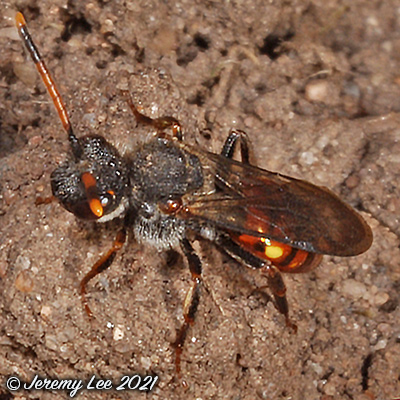
 |
|
Scientific Classifications explained » Amphibians » Ants » Aphids » Bees » Beetles » Birds » Bugs » Butterflies » Caterpillars » Damselflies » Dragonflies » Earwigs » Flies » Frog/Leafhoppers » Fungi » Galls » Grasshoppers » Harvestmen » Hoverflies » Lacewings » Ladybirds » Leaf Mines » Lichens » Mammals » Millipedes » Mosses » Moths » Sawflies » Slugs » Snails » Spiders » Trees & Shrubs » Wasps » Wild Flowers » Woodlice » Postboxes |
UK Nature > Bees > Nomada fabriciana

Scientific Name: Nomada fabriciana Common Name: Cuckoo Bee With over 850 species, the genus Nomada is one of the largest genera in the entire family Apidae, and the largest genus of cleptoparasitic cuckoo bees. They occur worldwide, and utilize many different types of bees as hosts, primarily the genus Andrena. As parasites, they lack a pollen-carrying scopa, and are often extraordinarily wasp-like in appearance with red, black, yellow colors prevailing, and with smoky (infuscated) wings or wing tips. Nomada fabriciana is a medium-small, reddish nomad with the unique combination of a black labrum and bifid (divided by a deep cleft or notch into two parts) mandibles. The female antennal flagella are usually orange with a broad black band and orange tip (a feature only otherwise seen in female N. armata and to a lesser extent N. zonata), but are occasionally all black or virtually all-orange. Females usually have small yellow spots at the sides of tergite 2 and ill-defined black bands across tergite 3 and 4, though the abdomen can be entirely red without yellow spots or have dark bands in some. The legs vary from extensively reddish to almost entirely black. Males resemble females but have black antennal flagella and often have yellow spots on tergites 2 and 3. This is a widespread and locally common nomad that seems to attack several Andrena species but primarily A. bicolor. It is bivoltine (having two generations a year) in most places with a strong spring generation and a weak late summer one. |
|

https://www.uknature.co.uk is a website dedicated to showing the immense diversity of UK nature and wildlife. Our vast range of habitats, from lowland arable to snow covered mountains, from storm-ravaged coastlines to peaceful inland freshwater lakes and rivers, from dry, sandy heaths to deciduous and coniferous forests, all these habitats contribute to the abundance of UK nature. We have wild birds in huge numbers either residing or visiting our shores (597 recorded species as at July 2013) and we must also not forget the humble back garden with its grass lawns, flower beds filled with nectar rich flowers, shrubs and trees, all designed to attract huge numbers of insects such as bees, moths, butterflies and hoverflies; and finally the small ponds which provide safe havens for frogs, toads, newts and even slow worms and grass snakes. www.uknature.co.uk is the showcase for my personal passion, photographing uknature in all its glory. I sincerely hope you all enjoy the fruits of my labours. This site and all images contained therein is © Jeremy Lee 2004 - 2025. All Rights Reserved. Site design by Jeremy Lee. Site development & IT Support by Stuart Lee. |